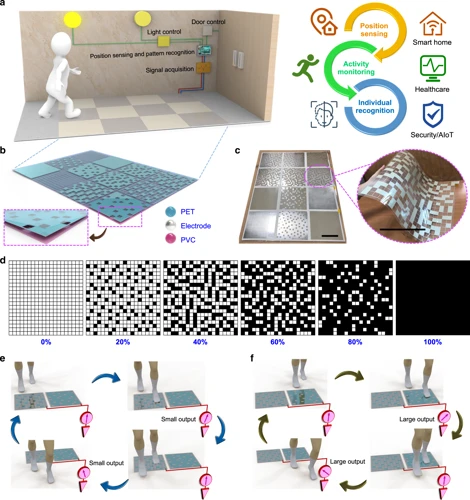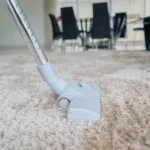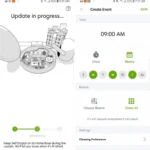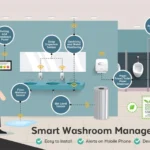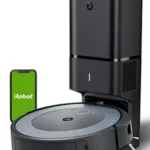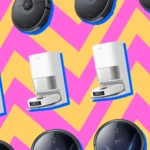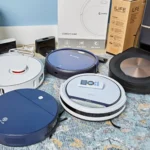Picture this scenario: you’ve just finished vacuuming your carpet, but as soon as you walk across it, you feel small bits of dirt and debris under your feet. Frustrating, right? Traditional vacuum cleaners can struggle to effectively clean carpets, especially those with deep pile or varying textures. But there’s a solution: smart sensors. In this article, we’ll explore the significance of smart sensors in carpet cleaning, explaining how they work and the benefits they bring to a notoriously tricky process. From adaptability to efficiency, we’ll dive into the ways smart sensors can solve common issues faced by traditional vacuum cleaners, and even look at their role in the future of carpet cleaning technology. So, let’s get started!
The Science of Smart Sensors
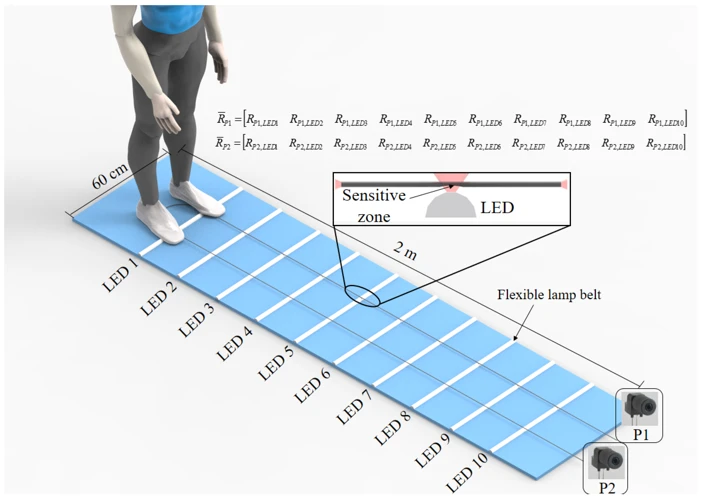
In today’s technology-driven world, we are constantly searching for new and more efficient ways to make our lives easier. The cleaning industry is no exception, and it’s no secret that keeping our homes and workplaces clean can be a time-consuming and often frustrating task. This is where smart sensors come in. These small but powerful devices offer a revolutionary new solution to the challenges of carpet cleaning. They are equipped with a range of capabilities, such as cleaning efficiency, obstacle detection, indoor mapping, and noise reduction. But what are smart sensors, and how do they work? Let’s take a closer look.
What Smart Sensors are and How They Work
Smart sensors are becoming an increasingly important part of carpet cleaning technology. These sensors utilize a variety of advanced technologies to detect and respond to different types of dirt, dust, and debris in a carpeted environment.
One of the primary benefits of smart sensors is their ability to adapt and adjust to different types of carpeting. This is possible thanks to a variety of sensing technologies including infrared, sonic, and laser-based sensors. By scanning the surface of the carpet, these sensors can detect changes in the texture, density, and composition of the fibers.
Table 1: Different types of smart sensors used for carpet cleaning
| Type of Sensor | How it Works | Applications |
|---|---|---|
| Laser Sensors | Utilizes a laser beam to measure distance and detect changes in the carpet’s surface | Can detect both large and small debris particles |
| Infrared Sensors | Measures changes in temperature caused by dirt and dust particles | Useful for detecting small particles that may not be visible to the naked eye |
| Sonic Sensors | Use sound waves to detect changes in the carpet’s surface and density | Can detect both large and small debris particles |
Smart sensors can also be used to target hard-to-reach areas of the carpet, where dust and debris tend to accumulate. Using high-precision sensors, these devices can detect and respond to changes in the carpet texture and density, allowing them to maneuver into these tight spaces and remove dirt and debris.
Table 2: Applications of smart sensors in carpet cleaning
| Application | How Smart Sensors Improve the Process |
|---|---|
| Adaptability | Smart sensors can detect changes in carpet composition and adjust the cleaning process accordingly |
| Precision | By detecting changes in texture and density, smart sensors can target hard-to-reach areas of the carpet more effectively |
| Efficiency | Smart sensors can speed up the cleaning process by detecting areas that require more or less attention |
As technology continues to evolve, it’s likely that smart sensors will become an even more essential part of carpet cleaning. By utilizing advanced sensing technologies, these devices can detect and respond to dirt and debris in new and innovative ways. Whether you’re a professional carpet cleaner or a homeowner looking to keep your carpets clean, smart sensors are poised to revolutionize the way we clean our carpets.
To learn more about the different types of sensors used in smart vacuums, check out our guide to Types of Sensors Used in Smart Vacuums. If you’re interested in how smart sensors are being used for obstacle detection, read our article on Smart Sensors for Obstacle Detection.
The Benefits of Smart Sensor Technology for Vacuum Cleaners
Smart sensors are revolutionizing the vacuum cleaning industry, changing the way we clean our carpets for the better. Here are some of the benefits of smart sensor technology for vacuum cleaners:
| Benefit | Description |
| Efficiency | Smart sensors can detect when a carpet is clean and automatically turn off the vacuum, saving time and energy. |
| Adaptability | Smart sensors can adjust the suction settings based on the type of carpet being cleaned, ensuring that the vacuum is operating at maximum efficiency. |
| Precision | Smart sensors can detect areas of high dirt concentration and adjust the vacuum’s settings accordingly, targeting dirt and dust in hard-to-reach areas. |
| Noise Reduction | Smart sensors can monitor the noise levels of the vacuum cleaner and adjust the settings to minimize loud noise. |
| Extend Vacuum Durability | Smart sensors can detect when a vacuum’s filter needs to be changed, ensuring that the vacuum is always operating at maximum efficiency and avoiding unnecessary wear and tear. |
| Improved Air Quality | Smart sensors can detect the quality of air in the room and adjust the vacuum settings to maintain a fresh and clean environment. |
Smart sensors provide numerous benefits to the vacuum cleaning process. From improving efficiency to enhancing air quality, smart sensors are changing the way we think about carpet cleaning.
The Problem with Traditional Vacuum Cleaners
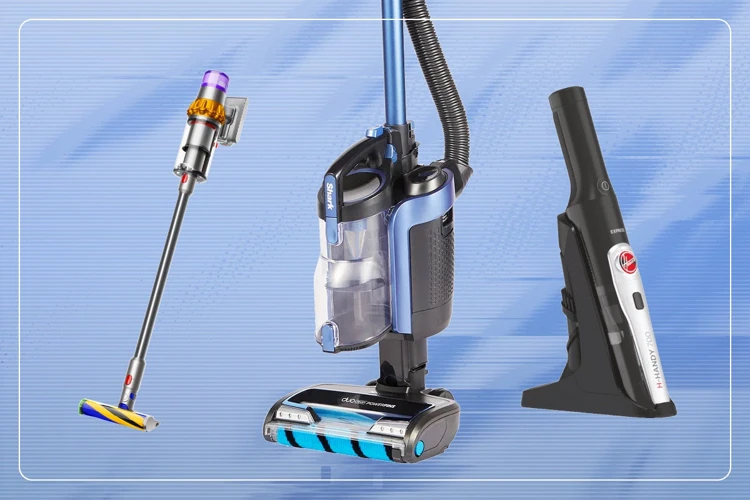
Despite being a household staple for decades, traditional vacuum cleaners have struggled to effectively clean carpets. It’s a perplexing issue–why are tools specifically designed for carpet cleaning falling short? The answer lies in the limitations of conventional technology. Traditional vacuum cleaners operate on a simple principle: suction. While this approach may be sufficient for cleaning hard surfaces, it falls short when it comes to deep cleaning carpets. The result is carpets that, despite regular vacuuming, harbor dust, dirt, and other allergens. Fortunately, new technology is changing the game. Smart sensors offer a solution to the problem of ineffective carpet cleaning, providing a more precise and efficient approach to home maintenance.
Why Traditional Vacuum Cleaners Struggle to Get Carpets Clean
Traditional vacuum cleaners have been a staple in households and commercial settings for many years, but they have their limitations when it comes to effectively cleaning carpets. Here we will discuss some of the challenges that traditional vacuum cleaners face in getting carpets clean.
| Lack of adaptability | Traditional vacuum cleaners have a fixed suction power and brush roll speed. This means that they are not able to adjust to different carpet types and pile heights, resulting in suboptimal cleaning performance. |
| Ineffective suction power | While traditional vacuum cleaners are powerful enough to pick up larger debris, they tend to be less effective at removing smaller, embedded dirt and dust particles within carpet fibers. |
| Inefficient brush rolls | Most traditional vacuum cleaners have brush rolls with fixed bristle patterns that may not be able to effectively agitate and loosen dirt and dust particles. Additionally, these brush rolls can become tangled and potentially damage the carpet fibers over time. |
| Poor filtration systems | Traditional vacuum cleaners often lack advanced filtration systems, which means that they may release dust and allergens back into the air during use, reducing indoor air quality and potentially causing health issues for those with respiratory sensitivities. |
These limitations can make it difficult for traditional vacuum cleaners to achieve the level of cleanliness that many consumers desire, especially in high-traffic areas or households with pets and children that require more frequent cleaning. Fortunately, advancements in smart sensor technology have enabled vacuum cleaners to address these challenges and provide more effective cleaning solutions.
The Importance of Adaptability and Precision in Carpet Cleaning
When it comes to the cleaning of carpets, adaptability and precision are two of the most crucial aspects that you need to consider. Carpets vary in terms of materials, thickness, and texture, which makes cleaning them a challenge. Carpet cleaning is not only about removing visible dirt but also those invisible microorganisms, allergens, and dust particles.
The importance of adaptability in carpet cleaning cannot be overstated. Smart sensors have the ability to detect the type of carpet and adjust the cleaning settings accordingly. This ensures that the cleaning is efficient and does not damage the carpet in any way.
A traditional vacuum cleaner, on the other hand, may not be able to adjust to different carpet types, resulting in either inadequate cleaning or damage to the carpet fibers. With smart sensors, you no longer have to worry about using the wrong cleaning settings or causing unnecessary damage to your expensive carpets.
Another important aspect of carpet cleaning is precision. Traditional vacuum cleaners rely on brute force and suction power to remove dirt and dust from carpets. However, this method is not very effective in removing dirt from hard-to-reach areas such as corners, edges, and tight spaces.
Smart sensors, on the other hand, have the ability to precisely target dirt and dust in hard-to-reach areas. The sensors can detect the exact location of dirt and adjust the cleaning settings to remove it effectively. As a result, you can be confident that your carpets are thoroughly cleaned without any hidden dirt or dust.
The precision of smart sensors also means that less effort is needed to clean your carpets. With traditional vacuum cleaners, you may need to go over the same spot multiple times to ensure all the dirt is removed. With smart sensors, you can achieve an efficient clean in minimal time.
The combination of adaptability and precision is what makes smart sensors an essential tool for carpet cleaning. If you’re looking for a reliable and efficient way to clean your carpets, you can’t go wrong with smart sensor technology.
How Smart Sensors Solve Common Carpet Cleaning Issues
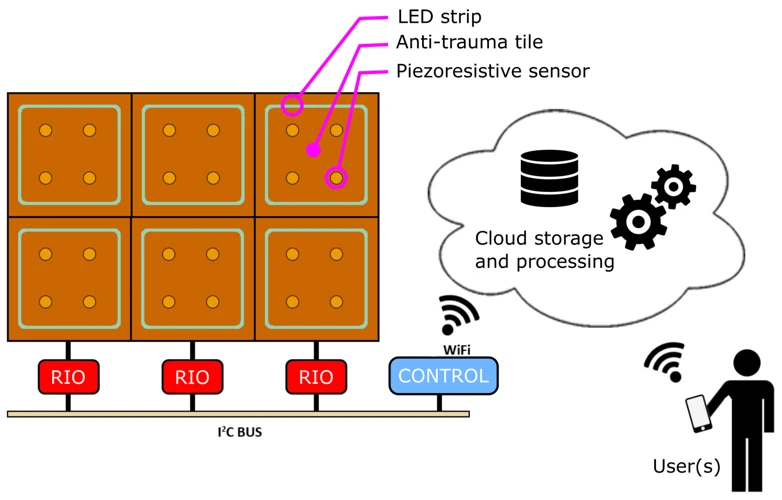
As any homeowner knows, cleaning carpets can be a daunting task. Traditional vacuum cleaners often struggle to fully clean carpets, leaving dust and dirt behind. This is where smart sensors come in. Smart sensors are a new technology that have revolutionized the vacuum cleaning industry. By adapting to different carpet types, targeting hard-to-reach areas, and improving efficiency, smart sensors help solve common carpet cleaning issues. In this section, we will explore the benefits and applications of smart sensors in carpet cleaning.
Adaptability: How Smart Sensors Adjust to Different Carpet Types
Smart sensors have revolutionized carpet cleaning by making it easier and more effective. One of the key benefits of smart sensors is their adaptability to different carpet types. This is crucial because not all carpets are created equal. Here are some of the ways that smart sensors adjust to different carpet types:
- Surface recognition: Smart sensors are designed to recognize the type of surface they are cleaning. This means that they can adjust their cleaning methods accordingly. For example, if the sensor detects a low-pile carpet, it will use a different approach than it would for a high-pile carpet. This ensures that the cleaning process is effective and efficient.
- Variable suction power: Smart sensors can adjust the vacuum’s suction power based on the type of carpet being cleaned. This is important because some carpets require a more gentle approach than others. With smart sensors, the vacuum can adjust its power as needed to avoid damaging delicate fibers.
- Height adjustment: Smart sensors can also adjust the height of the vacuum’s cleaning head. This is important because different carpets have different pile heights. If the vacuum’s cleaning head is too low, it can damage the carpet. If it’s too high, it won’t be as effective at removing dirt and dust. With smart sensors, the vacuum can adjust its height as needed to ensure that it’s cleaning the carpet effectively.
These adaptability features are extremely important because they ensure that the vacuum is cleaning the carpet in the most effective and gentle way possible. By adjusting to the different types of carpets out there, smart sensors make cleaning carpets an easier and more efficient process.
Precision: How Smart Sensors Target Dirt and Dust in Hard-to-Reach Areas
Smart sensors not only adapt to different carpet types but also help to target dirt and dust in even the hard-to-reach areas. This is where precision comes in. Instead of simply relying on the suction power, smart sensors have the ability to detect where there is more dirt and dust and focus on that area to give a thorough clean. Here’s how they achieve precision:
- Mapping: Smart sensors use various technologies like lasers and cameras to map a room accurately, including the furniture and other obstructions. This helps the vacuum cleaner to find the objective with more accuracy without damaging other parts of the room.
- Scheduling: Nowadays, smart sensors come with a range of features to schedule cleaning during a certain time of the day, especially when no one is in the room. It can detect the correct spots to clean for an efficient clean swipe.
- Spot cleaning: Smart sensors help to locate spills, dust, and dirt present in the nooks and corners of the room. Once detected, it comes with the capability to clean that specific area and also stop cleaning when no dirt is left to clean.
- Self-cleaning: With smart sensor technology, cleaning procedures are bound to be more refined as they use laser guidance to find their way around the mess. There are automatic self-cleaning modes available that kick in every time the sensor detects dirt and dust. This helps to remove debris or dust present in hard-to-reach areas without manual interruption.
With these techniques, smart sensors ensure that every corner of the carpeted area is cleaned thoroughly, and no spot is left dirty. Precision is key when it comes to smart sensor technology, and it helps to take carpet cleaning to the next level.
Efficiency: How Smart Sensors Help You Get the Job Done Faster
Smart sensors not only improve the adaptability and precision of carpet cleaning but also make the cleaning process more efficient. Here are some of the ways that smart sensors can help you get the job done faster:
- Targeted Cleaning: Smart sensors can detect high-traffic areas or heavily soiled spots, allowing the vacuum cleaner to focus its cleaning efforts in those areas. This targeted cleaning approach ensures that dirt and dust are removed quickly and thoroughly, reducing the amount of time you spend cleaning.
- Automatic Adjustments: With traditional vacuum cleaners, users have to manually adjust the suction power and brush roll speed based on the type of flooring. However, smart sensors can automatically detect the type of flooring and make these adjustments for you. This eliminates the need for constant adjustments, saving you valuable time.
- Real-time Monitoring: Smart sensors can monitor the cleaning performance in real-time and make adjustments as needed. For example, if the vacuum cleaner sensors detect that the airflow is restricted due to a clogged filter or full dustbin, it will send an alert to the user to take corrective action. This prevents the vacuum cleaner from becoming less effective over time and helps keep the cleaning process efficient.
- Faster Cleaning Cycles: With smart sensors, you can also reduce the number of cleaning cycles needed to get the carpets clean. The sensors detect when the carpet is clean and do not initiate further cleaning until it is needed. This reduces the total cleaning time and ensures that the carpets are not overcleaned, which can damage the carpet fibers and reduce their lifespan.
By incorporating smart sensors into vacuum cleaners, users can reduce the time spent cleaning and achieve better cleaning results. These sensors help to ensure that dirt and dust are removed quickly and efficiently, while also preserving the lifespan of your carpets.
The Future of Carpet Cleaning: Smart Sensors and Beyond
As technology continues to advance and evolve, the future of carpet cleaning looks bright. With the emergence and increasing popularity of smart sensor technology, the industry is evolving at a rapid pace. Smart sensors are just the beginning – the potential for innovation in this field is immense. From adapting to new cleaning surfaces to increased efficiency and precision, the future of carpet cleaning is taking shape before our eyes. In this section, we will take a closer look at the advances in smart sensor technology and what they mean for the future of the vacuum cleaning industry.
Advances in Smart Sensor Technology and What They Mean for Carpet Cleaning
As technology continues to evolve, smart sensor technology is no exception. There have been significant advances in smart sensor technology in recent years, and their impact on the carpet cleaning industry is notable. Here are a few ways that these advances are changing the way we look at carpet cleaning:
1. Improved Accuracy: Smart sensors are now more accurate than ever before. They can detect smaller particles and target them more precisely. This means that dirt and dust will be removed more thoroughly, leaving carpets cleaner and fresher.
2. Enhanced Adaptability: With the latest smart sensors, carpet cleaning machines can now adapt to different types of flooring. From hardwood to rugs and carpets, smart sensors can adjust to various surfaces and deliver a top-notch cleaning experience.
3. Greater Efficiency: Smart sensors are also increasing efficiency with cleaning machines. They are now able to detect where dirt and dust is accumulated and provide a more targeted cleaning process. This saves time and energy, resulting in more efficient cleaning.
4. Increased Automation: As smart sensors become more advanced, they are also becoming more automated. This allows cleaning machines to operate independently and deliver a precise cleaning service. Homeowners and business owners do not have to worry about manual adjustments, allowing them to focus on other tasks while the cleaning is being done.
These advances in smart sensor technology mean that carpet cleaning is becoming more effective, efficient, and automated. As technology continues to improve, it is likely that we will see further advances in smart sensor technology, opening up even more possibilities for the future of carpet cleaning.
How Smart Sensors Will Continue to Revolutionize the Vacuum Cleaning Industry
The evolution of smart sensor technology has brought about a revolution in the vacuum cleaning industry. Vacuum cleaners equipped with smart sensors have now become the norm, and this trend is expected to continue in the future.
Smart sensors have allowed vacuum cleaners to become more efficient, adaptable, and precise in their cleaning. With advances in technology, smart sensors will continue to revolutionize the vacuum cleaning industry by offering even more benefits.
Increased Efficiency
One of the most noticeable benefits of smart sensor technology is increased efficiency. Smart sensors allow vacuum cleaners to optimize their cleaning patterns and adjust suction levels based on the environment. This means less time spent going over the same area multiple times and more thorough cleaning in less time.
More Adaptability
Smart sensors also allow vacuum cleaners to adapt to different cleaning environments. With smart sensors, vacuum cleaners can adjust to different types of flooring and furniture, allowing for a more comprehensive clean. This also means that traditional problems associated with cleaning different types of carpets are a thing of the past.
Greater Precision
Smart sensors also mean greater precision in cleaning. These sensors can detect the presence of dirt, dust and other particles for optimal cleaning. They can zoom in on hard-to-reach areas for highly-targeted cleaning.
Additional Benefits
In addition to increased efficiency, adaptability, and precision, smart sensors have numerous other benefits. These include:
- Improved battery life, allowing for longer run times
- Lower energy consumption, resulting in lower electricity bills
- Quiet operation, making it easier to clean while others are in the home
- More convenience, thanks to features like auto-recharging and remote control
These and other benefits of smart sensor technology in vacuum cleaners will continue to revolutionize the industry in the future. As smart sensors become more advanced and affordable, we can expect to see even more innovative products hitting the market.
Conclusion
In conclusion, it is clear that the utilization of smart sensor technology has revolutionized the way carpets are cleaned. By utilizing adaptability, precision, and efficiency, these advanced sensors offer a solution to common cleaning issues that traditional vacuum cleaners struggle to address.
Through the use of smart sensors, vacuum cleaners can now easily adjust to different carpet types, target hard-to-reach areas, and complete tasks faster than ever before. As technology continues to advance, we can only expect even more impressive developments in the field of smart sensor technology and its impact on the carpet cleaning industry.
It is exciting to consider the vast potential applications of smart sensor technology, not only in carpet cleaning but in other areas of home maintenance as well. With the ability to optimize and streamline cleaning processes, smart sensors may serve as the key to maintaining a clean and healthy living space.
Therefore, it is highly recommended that household cleaning tools, like vacuum cleaners, should incorporate this technology for better functionality, more accuracy, and to save time. So, let’s embrace the future of carpet cleaning with smart sensors and witness a more efficient and effective cleaning process like never before!
Frequently Asked Questions
How do smart sensors work?
Smart sensors use technology such as infrared, acoustic and ultrasonic sensors to detect and measure various physical and chemical properties of the surrounding environment.
What are the benefits of smart sensor technology for vacuum cleaners?
Smart sensors help vacuum cleaners become more adaptable, precise, and efficient in cleaning carpets. They are capable of detecting dust and dirt on carpets and adjusting their performance accordingly to clean more effectively.
Why do traditional vacuum cleaners struggle to get carpets clean?
Traditional vacuum cleaners often have a one-size-fits-all cleaning solution that lacks adaptability to different carpet types. They are not precise in targeting hard-to-reach areas and often miss dirt and dust particles.
What is the importance of adaptability and precision in carpet cleaning?
Adaptability and precision are essential for carpet cleaning as each carpet type has unique cleaning requirements. Precision ensures that all dirt and dust particles are targeted for removal, while adaptability ensures that the vacuum cleaner can adjust its performance based on the carpet’s unique cleaning requirements.
How do smart sensors solve common carpet cleaning issues?
Smart sensors solve common carpet cleaning issues by adjusting the vacuum cleaner’s performance based on various properties of the carpet, such as its thickness and pile height. These sensors also ensure that the vacuum cleaner is precisely targeting dirt and dust in hard-to-reach areas, making the cleaning process more efficient.
How does adaptability work in smart sensor technology?
Smart sensors use various technologies, such as pressure sensors or image processing, to adapt to different carpet types. These technologies analyze the carpet’s properties and adjust the vacuum cleaner’s performance accordingly.
How does precision work in smart sensor technology?
Smart sensors use pinpoint lasers or image processing to analyze every inch of the carpet and locate hard-to-reach areas. These sensors then adjust the vacuum cleaner’s performance to ensure that it targets all dirt and dust particles in these areas effectively.
How do smart sensors improve efficiency?
Smart sensors improve efficiency by eliminating the need for manual adjustments to the vacuum cleaner’s cleaning settings, reducing the time it takes to clean a carpet. They can also detect areas with the most dirt and dust particles and focus on cleaning these areas first.
What are the latest advances in smart sensor technology?
Recent advances in smart sensor technology include the use of machine learning algorithms and artificial intelligence to map and analyze carpets’ unique cleaning requirements, ensuring the most effective cleaning possible.
How will smart sensors revolutionize the vacuum cleaning industry?
Smart sensors will continue to revolutionize the vacuum cleaning industry by providing more efficient and effective cleaning solutions. With advances in technology and the integration of artificial intelligence, vacuum cleaners with smart sensors will continue to adapt to different cleaning requirements and provide optimal carpet cleaning results.
